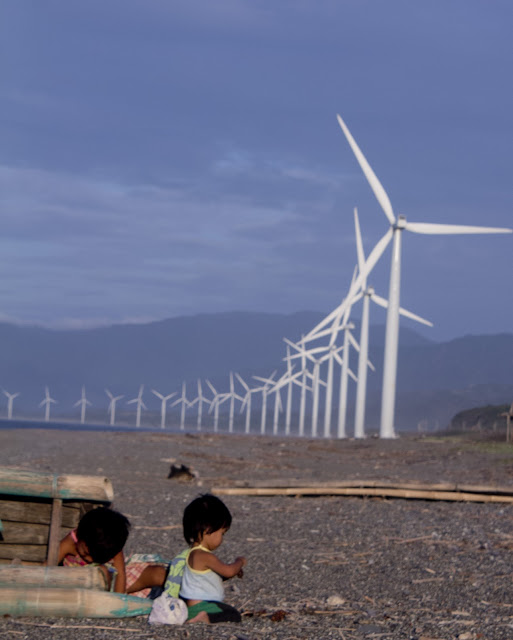The first mission of Bangui was established by the Augustinians of February 14, 1607 supposedly at the request of one Capitan Ribero, the encomendero of the place. The natives who rejected baptism were called pagans and they were driven away from their lands. Those who accepted baptism were called Christians. In 1624, the town was made into a parish with Father Pedro Valenzuela as the first minister. The Spanish missionaries considered the date as the foundation year of Bangui.
During the revolution in 1896, the remnants of the Spanish army in Luzon, driven b superior Filipino forces under the command of General Jorico retreated to Bangui and took their last foothold in the are.
Bangui is famous for its swimming resort along a circumferential bay which is considered as the best scenery in the whole island of Luzon. The livelihood of the people comes from farming, fishing, and mat-making. The construction of the P1.8 Million Lipsoc communal irrigation dam project in Bangui is a boon to its agricultural economy. The dam can irrigate 205 hectares of land and will benefit some 300 farmers in seven adjacent barangays, resulting in increased production of rice, corn, garlic, vegetables, and mongo.
Bangui today is already considered as an urban community. It is groomed as a possible site for a free port or specialized economic zone because of its favorable location. Furthermore, when the Laoag-Allacapan road is fully completed, it will enhance Bangui’s emerging prominence, extending its influence as far as the eastern towns of Cagayan Province.
I
it was my first time conquering Ilocos Sur, the land of my ancestors (mother side). My primary aim there together with my family was to have the grasp of the heritage that our Filipino ancestors left during the Spanish colonial era. Vigan City was one of them of course, but I have set my eyes towards one of the four baroque churches inscribed in the World Heritage List, the Santa Maria Church or Iglesia de Nuesta Señora de la Asuncion (Simbahan iti Asunta sa Ilokano).
The Church of Santa Maria or sometimes called Santa Maria de Assunta Church is found at the town of Santa Maria in the province of Ilocos Sur, about an hour away from Vigan City. This magnificent ancient structure is located in the town’s narrow hill overlooking the poblacion (town proper) and its vast plains and hills. The church compound is made up of the church itself, the belfry and the convent in front of it. If you are a Kapamilya fan, you should’ve seen this in their soap opera “Panday.”
Built starting in 1810, it was believed to be the place where the Blessed Virgin’s image was frequently found after series of disappearance during the Spanish colonial period. (Sounds very familiar to other stories in the islands as well.) The church was made by the Ilocanos under the supervision of the Agustinian friars (therefore it’s an Agustinian church, same as with the rest of UNESCO’s baroque churches in the country!). The church is dedicated to its patroness Our Lady of Assumption or La Nuestra Señora de la Asuncion.
The church itself is narrow, made up mostly of red bricks, stone and lime. In detail, the church’s decors on the wall have its floral design. The façade itself, although not intricate, yet simply has a rectangle column with massive circular buttresses on its side soaring towards the urn finials on the top of the pediment. The façade of the church is blocked by a bridge linking the church and the convent some few meters away. The buttresses on its sides serve as its protection against possible collapse. On its northwestern walls, there is a mural of Our Lady…but I heard that this is somehow a more recent addition to the church and not during the construction of the church itself. The narrowness of the hill has somehow made this impressive and massive structure a bit smaller compared to its sisters in Ilocos. However, this factor was one of the reasons why it is one of the most outstanding in its simplicity of its baroque features.
Going there:
We went there upon returning from our trip to Vigan. Again, its about an hour away either by private or public buses. The most convenient way for you to access Santa Maria are Ilocos-bound buses such as Farias, Partas, Viron bus lines that serve either Laoag, Vigan in Ilocos or Bangued in Abra. The fare directly to Santa Maria is probably approximately between PhP 400 to PhP 500 one way and its about 7 hours trip from Manila. (Well, last year, it was a grueling 14 hour ride, almost all of the cars in Metro Manila I think left for the provinces, and major traffic jams that lasted for miles occurred in Dau, Tarlac and most especially Rosales-Villasis-Urdaneta area!)
































No comments:
Post a Comment
Thank you for dropping by! ♥
I may not seem to reply (most of the time) but rest assured, I read and appreciate all your comments.
I will get back to your questions and inquiries so please make sure to leave a trace - your website or your email ad will do.
..and by the way, I ignore questions where details are already found in my blog entry. Read first, then ask. Sounds better, right?